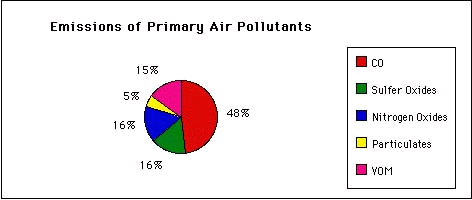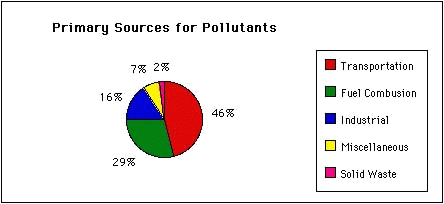
Carbon Monoxide
Carbon monoxide is a odorless, poisonous gas. It is created when gasoline does not completely burn. 60 million metric tons of carbon monoxide gets put into the air each year in the United States. Carbon monoxide can harm cells which obtain oxygen through hemoglobin in a blood pigment. Hemoglobin prefers carbon monoxide to oxygen.
Ozone or photochemical smog is created when two primary pollutants, hydrocarbons (toxic compounds found in fossil fuels) and nitrogen oxides (gases produced by high temperatures and emitted from vehicles), react with sunlight. In the upper atmosphere ozone protects us from the sun's ultra violet rays. Lower in the atmosphere ozone is caused by a photochemical reaction with sunlight. Smog is an accumulation of brown, hazy fumes, that will irritate the eyes and lungs, lowers resistance to colds, can impair athletic performance, causes damage to our lungs, affects individuals with hear and lung diseases, and causes damage to plant life. Particulates are small solid particles like soot, dust, bits of metal, rubber and other material, and liquid droplets that are suspended in the air. The dispersal of airborne particulates in the atmosphere because of human activity has become a concern because of health related problems to living things.
Below is the percent of each type of pollutant that is released into the atmosphere:

Air Pollution: Pollution is any gas, chemical or organic matter that contaminates the atmosphere. The presence of contaminating substances may adversely affect human health.
Emissions: waste substances discharged into the air as a result of some activity.
Sources of Air Pollutants
Ozone and Photochemical Smog: The pollutants that create smog (nitrogen oxides and hydrocarbons) come from automobile emissions, paint and solvent and gasoline vapors.
| Nitrogen Oxides |
Volatile Organic Compounds or Hydrocarbons |
Carbon Monoxide |
|||
| Vehicles Electric Utilities |
34% 34% |
Vehicles Painting/Coating Wood-Burning Stoves |
24% 12% 11% |
Vehicles Forest Fires Wood-Burning Stoves |
54% 11% 10% |
Particulates: Natural sources of particulates include dust, volcanic ash and pollen. Human sources of particulates include dust from plowing and overgrazing of arid land, mineral dust from mining and smelting, coal and oil burning power plants, ash and smoke from industries, vehicles, particularly those that burn diesel fuel, and burning wood in fireplaces and wood burning stoves. Liquid particulates include sulfuric acid, PCB's, oil and pesticides.
Below are the percentages of the primary sources of all air pollutants:

The Atmosphere
Air is all around us yet we can not see the gases that make up Earth's atmosphere. The earth's atmosphere is a very thin layer. The atmosphere mainly contains the gases Nitrogen (78%) and Oxygen (21%). The rest of the atmosphere is made up of trace gases and particulates. These include water vapor, ozone, carbon dioxide, argon, neon, helium, hydrogen, methane, nitrous oxide, xenon, and chlorinated fluorocarbons.
